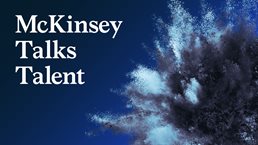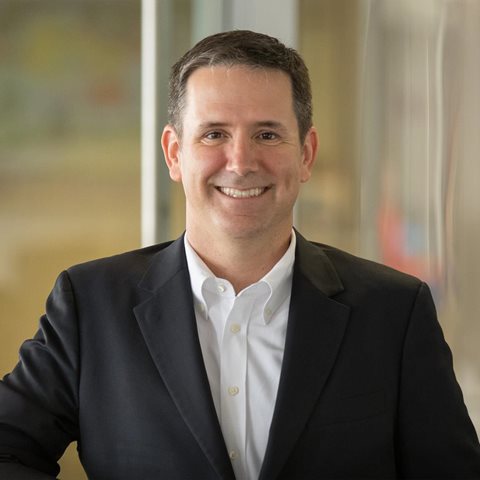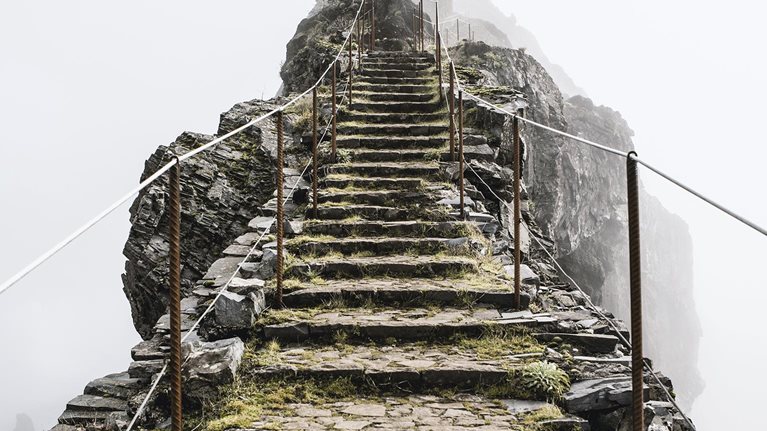Office rituals matter—and in a range of ways. But the pandemic has made many rituals moot, at a time when employees need them most. In this episode of the McKinsey Talks Talent podcast, talent leaders Bryan Hancock and Bill Schaninger talk to global editorial director Lucia Rahilly about how to develop rituals for the changing world of work—and what all of us stand to lose unless rituals are revitalized.
This transcript has been edited for clarity and length.
What’s a workplace ritual, really?
Lucia Rahilly: Last week, I was talking about this episode with our amazing podcast producer, Laurel Moglen, and she told me one of her team members asked, “What is an office ritual?” This person is Gen Z, and she was hired during the pandemic—so she just hasn’t been in the workplace during a period when office rituals have been well established. What would you do in a case like that?
Bill Schaninger: One of my banking clients hired lots of people when we were out of the office, and we actually encouraged them to re-onboard everyone. Acculturation requires interaction with other human beings. How we dress, how we show up—all those behavioral cues come from seeing other humans.
Gen Z tends to be much more comfortable than previous generations with sitting next to each other and texting rather than speaking—very comfortable with digital interaction in place of in-person interaction. That’s not surprising given that many of them went from the last year or two of college being largely remote into a first-job situation. But it’s not growing an employee who’s thinking about “we.” It’s growing a contractor who’s thinking about “me.” We have to reboot—bring these newer employees together and show them why wearing the badge should matter.
Bryan Hancock: We’re having a winter welcome party at our house for everybody who joined during the pandemic. It introduces new folks to the idea that we get together to say, “Welcome. We’re glad you’re here.” It’s an intentional gathering where we recognize that our work lives are more than what we individually contribute. You demonstrate ritual through a few of those instances, and then people get it.
Lucia Rahilly: What do we mean when we talk about rituals in the context of the workplace?
Bill Schaninger: The basic idea is that rituals are a repeated act, a custom. Typically, when you talk about ritual in the workplace, you’re almost always grouping it with other elements that help define culture, as in the classic Ed Schein definition of culture rooted in rights, rituals, ceremonies, language, behaviors, and generally accepted norms and values.1
The short version? Rituals are what make us us. What we do that you can count on. What matters to us. Rituals are almost always episodic, though, in that they’re triggered by something else—a milestone, for example.
Bryan Hancock: Right. Rituals usually have a community aspect. A ritual is not just you alone; it’s something you do together. “Congratulations, you got elected partner. We’re going to have a dinner together to recognize that. And we’re going to have toasts at that dinner.” That’s community recognition. Rituals are an important part of how we are the community that we are at work.
Lucia Rahilly: What do rituals help us achieve in the workplace?
Bryan Hancock: One thing rituals do is make connectivity easier to achieve. My wife has a great ritual in her workplace, where one person calls out with gratitude what somebody has done that week, then passes that role on to another person for the following week. That’s one form of a ritual.
Another is recognizing that something significant has happened—that a colleague has accomplished something, crossed a threshold. I worked at a law firm that had first-deal dinners for members of the corporate team. So rituals can be routine ways to acknowledge being together, acknowledge one another, as well as to recognize what is, by definition, not routine—a first, a transition, a movement to what’s next.
What makes rituals powerful?
Lucia Rahilly: What I’m hearing you say is that rituals don’t only have to be rites of passage—promotions, retirements. They can be at a more frequent cadence—daily, weekly. Is that right?
Bill Schaninger: Daily and weekly rituals are quite interesting. Long ago, when I ran a residential psychiatric treatment center, the only day all the staff were in was Wednesday. And every Wednesday night, the supervisors took the staff out for food and drinks—you could count on it. There are acts that are ritualistic, and because you can count on them, look forward to them, they start becoming part of the tie that binds. Or take my daughter’s field hockey team. They carb load the night before games, and they all look forward to it, because they rotate houses.
Lucia Rahilly: The field hockey example is interesting in that there’s an abundance of sports psychology research on the value of preperformance rituals—whether that’s LeBron [James] throwing chalk before the basketball game or Phil Jackson and his Lakota-Zen-mindfulness thing. Is there similar research on the value of rituals at work?
Subscribe to the McKinsey Talks Talent podcast
Bill Schaninger: Yes. Think of habit building for individuals; rituals are similarly good for groups. They’re good for the broader organization. They’re very good for teams. And part of that is, “This is what we do together and for each other.”
Bryan Hancock: Research shows that the rituals that work tend to have two aspects. One is explicit community building. The second is usually a physical aspect: being together, raising a glass, making a toast. The second is what, during the pandemic, was jeopardized.
Some organizations have been very intentional about bringing that physical aspect back, and some haven’t. For those who haven’t, it would be interesting to see whether they’re missing something they had before. Are they lagging in terms of the ties that bind relative to organizations that were intentional about bringing rituals back?
Lucia Rahilly: Loneliness at work and in society more broadly were already on the upswing prepandemic—and then lockdowns sent those feelings spiking. Any examples of remote rituals introduced during the pandemic that you think helped—that folks actually liked?
Bill Schaninger: I know many that people don’t like: cocktails over Zoom, for example.
Lucia Rahilly: One amazing ritual introduced during the pandemic—not a workplace ritual but related to work—was quarantine clapping for frontline workers. I live in New York City, and we looked forward to that every night. It was so moving. Kids did it. Older folks did it. We all did it—everybody opened their windows and clapped.
In the workplace, you tell me. Did you see clients doing anything interesting? There was certainly a lot of virtual watercooler activity and remote wine tasting or chocolate tasting.
Bryan Hancock: Cat Ward, at Jobs for the Future, told us about Mindful Mondays. They were a time for reflection across the team—a shared way of reflecting, both individually and communally, on how the week was going. And they were a ritual that lent itself both to in-person and virtual interaction.
I like Mindful Mondays because they’re different from having drinks over Zoom. There’s a different intentionality behind them, a different purposefulness—both for the individual and the collective—that I thought was cool, and a good example of what was done during the pandemic that could extend beyond.
Lucia Rahilly: There’s a kind of formlessness in an always-on, remote world in which you can’t differentiate the weekend from any other day—it’s fatiguing for folks. Mindful Mondays addresses that. It brings in personal life, it brings the idea of “the weekend” right into your Monday morning, it demarcates the beginning of the week. I love that example. Any others?
Bill Schaninger: When our Philly office was small, when we had really good attendance Fridays at lunch, we would do a go-around and ask, “Who did something cool this week?” Junior folks got to hear the breadth of what we were doing—but they also got to talk with pride about a cool thing they themselves worked on that week. It doesn’t sound all that profound—but the actual practice, the habitual part, is what made it a ritual. You do something like that and soon everybody counts on it. And if you miss it even once, people notice.
Bryan Hancock: There’s a part of this I’d love your thoughts on, Bill. “Spiritual” can mean aligning with a purpose, aligning with something beyond yourself. I’d love your thoughts on ritual as spiritual in the workplace. How do we think about ritual as aligning with purpose at work?
Bill Schaninger: The extent to which rituals help employees feel a part of something bigger, help them get energy—help them know their jobs aren’t just about the tactical—is always good. In my time at McKinsey, we had a group of associates, most of whom were struggling with the dot-com crash, gather on Fridays. We did a lot of meditation, saying, “Before we go into this meeting, let’s get together quietly for a moment and center ourselves and agree on our intention, what we’re trying to do here.” That’s not everyone’s cup of tea. But when a group shares that cup of tea and believes it’s useful, it can be quite powerful.
When is a ritual a ritual—versus forced fun?
Bryan Hancock: We asked folks on social media about rituals, and one responded, “Some of these events people call rituals—what if a lot of people don’t want to go? Because it feels forced; it’s not authentic.” To me, the difference between an event that feels like forced fun and a ritual with meaning is some form of spiritual connection, connection to a broader purpose.
The difference between an event that feels like forced fun and a ritual with meaning is some form of spiritual connection, connection to a broader purpose.
Lucia Rahilly: Suppose you’re a leader and you’ve been intentional about introducing new rituals throughout the remote period. To your point, Bryan, folks can invest very different meaning in different rituals. What if the ritual you love is your employees’ big eye roll?
Bryan Hancock: You have to take a step back and ask yourself, “Is this really a ritual? Is this something that’s truly communal, that truly has meaning?” If I’m getting 20 percent, 30 percent, 40 percent eye rolls, I’d ask, “What do I need to do to better infuse a common sense of purpose here? What do I need to do to infuse more commonality?” If a ritual isn’t landing for the broader community, I’ve got more work to do—maybe on the ritual, but maybe on the underlying connectivity, purpose, and sense of meaning.
Bill Schaninger: You may just need to go back to more microsize rituals that are easier to land and build from there. When our Philly office was smaller, Values Day always had two components. Morning was service, and we loved picking a Philly charity where we’d volunteer—all of us. And then afternoon was our version of The Amazing Race: teams would run around Old Town Philadelphia. We’d end by having senior folks serve associates—bring them food at the end of the day. There was something about the idea of service throughout the day, in different versions. It was a signature event for us.
Rituals have to feel special to everybody or very quickly you’ve got to come to grips with the fact that maybe your culture is not quite as mono as you thought.
Lucia Rahilly: Some rituals start serendipitously: behavior sparks connection or fellow feeling and gets repeated, and then through that repetition, gets imbued with the kind of meaning you’re describing. If you’re a leader thinking about how to introduce a new ritual, how do you encourage folks to overcome initial resistance and give it a go?
Bill Schaninger: When leaders really started thinking about inclusive work environments, they realized, for example, that having drinks at every event is problematic. Or take an office where lots of folks are having children. If you make every event child-friendly, suddenly you have some younger employees asking, “When do we get to go to the local pub?” In these cases, have you truly created a tie that binds for everyone?
A good practice is filling in the blank: “We always do this because …” When my son was playing hockey, we always ate at the same restaurant because a couple times in a row, we ate there and the Flyers won. Then we had to do it—and then at some point they got smoked and we questioned the efficacy of that ritual. But sometimes it’s as simple as asking, what do we do that both conjures a memory and also feels like “our inside thing”?
Bryan Hancock: Marking a transition is so natural. You can’t go wrong welcoming someone or recognizing a first-time accomplishment or a departure. Any transition is a time to reflect and celebrate as a group. As a leader, I would lean into those.
Moving from ‘me’ to ‘we’
Lucia Rahilly: Are you seeing a lot of prepandemic rituals reemerge at the same scale as before, or have they been hard to reintroduce?
Bill Schaninger: At minimum, a two-year break in the norm means all bets are off. Optionality is what I worry about most—when we’ve backed our way into “my work,” versus “our work.”
It’s hard. People work at different times of the day, in different places. How do we get back to the “we”—but without it sounding like a mandate? You want to convey that there’s an expectation to be part of this group, and part of that expectation is your presence, because it’s what makes us us. It’s a tough line to walk, but it’s necessary if you want a crew that’s knitted together, not a group of vendors.
Bryan Hancock: If I were starting up a ritual, I would ground it in two things: mindfulness and gratitude. If you start with that combination, good things will happen. It won’t feel forced; it will come from a good place. Other things can build when you start from that link to a broader purpose and a recognition of what’s more than just you. That’s at the core of what the truly great rituals are.
Lucia Rahilly: We’ve been talking about engineering rituals from the top down. Are there ways leaders can foster the development of rituals from the bottom up? Some of the bottom-up rituals are the most fun.
Bill Schaninger: Anywhere there’s more than one person, and there’s repetition and routine, there’s the opportunity for ritual. Long ago, I used to go with a team from Chattanooga to Hartsville every Thursday. There was a moment when one colleague changed from her work gear into her flying gear—and that’s when the team knew we were going out to eat. When she changed into her jeggings and sweatshirt, it was time for Thursday night food, which was a great way, as a team, to celebrate the week and acknowledge people: “Oh, we know this person is going to get engaged this weekend. Let’s get excited.”

McKinsey Talks Talent Podcast
Bryan Hancock, Brooke Weddle, and other talent experts help you navigate a fast-changing landscape and prepare for the future of work by making talent a competitive advantage.
Lucia Rahilly: We had some LinkedIn feedback on happy hours and the benefit for relationship building, which is a classic team-building activity. But to your earlier point, Bill, not everyone drinks. As a leader, how should you think about inclusivity and rituals?
Bryan Hancock: For me, it comes down to intentionality. If you’re having a happy hour and the purpose is to express gratitude for what folks have done—buy somebody a drink and say, “Hey, thanks. I know it’s a hard week”—that’s a pretty good happy hour, whether you’re drinking alcohol or not. The purpose isn’t the bar; it’s to express gratitude. And if the venue is happy hour, and that’s one that everybody’s comfortable with, great. If not everybody’s comfortable with it, find another way to express the same gratitude in a way that’s inclusive.
Recently, I went to a happy hour in Atlanta at a great tapas place, and I don’t think anybody even had anything to drink—we just grabbed something light before we headed home. We still considered it a happy hour, even though we weren’t drinking. Messaging is critical. The ritual isn’t to drink, the ritual is to be together and say thanks. As a leader, you’ve got to be thoughtful about how a ritual advances togetherness.
What we’ve lost—and what’s at stake
Lucia Rahilly: During the pandemic, we decoupled work from geography. Folks scattered; hiring stretched across regions. How does the persistence of hybrid complicate the development and the durability of rituals in our working lives? Most rituals, to Bill’s point, centered on in-person activity in the past.
Bill Schaninger: First, let’s remember that the majority of workers are not hybrid. They’re still going to work. And those folks desperately need rituals. There’s a huge swath of the workforce that does not feel respected or valued. So I would encourage us to keep thinking about rituals for people who still go to the workplace daily.
Let’s remember that the majority of workers are not hybrid. They’re still going to work. And those folks desperately need rituals.
In the hybrid context, I worried when we opened up the possibility, “You can live wherever you want.” I wasn’t sure how we’d ever get back to meaningful ties. And I think we’re probably going to pay for that for a couple years, honestly.
Bryan Hancock: Hybrid requires you to be more explicit about what a ritual is and why. “We’re having a Mindful Monday to think about our purpose and where we’re aligned.” “We’re having a gratitude email chain.” Those work perfectly well via hybrid, and they engage and bind us together. Put the reason you’re doing them in the title of the email. That way you know what it is—or as one of my British colleagues says, “It says on the tin what it is.”
Lucia Rahilly: Do you have a favorite prepandemic ritual that hasn’t resurfaced?
Bryan Hancock: Farewell dinners. Before the pandemic, if a colleague went to another firm or retired, you would absolutely have a dinner—get together, share great stories. You’d often include families and have a send-off that left everyone a little sad and a little happy about the evening.
Over the course of the pandemic, when folks left, suddenly they just weren’t on Zoom anymore. It became accepted that things had changed. Working remotely made farewell dinners seem hard to orchestrate. And I haven’t seen them come back. If there was one ritual I wish would come back, that’s the one.
Lucia Rahilly: Why do you think farewell dinners haven’t reemerged? A farewell dinner doesn’t require weekly presence in the office. It’s a special occasion.
Bill Schaninger: I think we’ve lost our way a bit, in that just because you can do something virtually doesn’t mean you should. Sending a well-crafted email celebrating someone leaving is just not the same as getting together and having a little bit of roast, a little bit of toast. Knowing that, say, four people traveled and made an effort to get there—that matters.
Lucia Rahilly: What’s at stake if leaders neglect the role of rituals in the workplace?
Bryan Hancock: It weakens the link to purpose. It weakens the link to the manager. And it weakens the ties across the organization. All three of those are critical for company performance, critical for retention, and critical for the well-being of individual workers. And we lose all of them.
Bill Schaninger: We used to say, “Culture is happening whether you manage it or not.” There will always be pockets of employees who get together and create rituals. But as a leader, you have to decide whether to have a ritual for the big “we”—the big group. Left unchecked and unmanaged, rituals risk becoming more proximal, involving people right around you or whom you’re directly connected to. And you’ll never really get the scale benefit of a broader tie that binds.
Lucia Rahilly: There’s a risk also of folks looking outside the workplace to establish rituals—which is great. But when personal rituals start to supplant office rituals, folks might become more tied to life outside work and office relationships might become more transactional.
Bryan Hancock: Very much so.
Lucia Rahilly: Bill, did you have a favorite ritual you wanted to call out?
Bill Schaninger: I really do enjoy food-based rituals. We got a comment on one of our social-media posts on rituals about frying a turkey out in a maintenance shop. And listen, that takes work. It takes effort. You’ve got to get the bird. You’ve got to get the oil. You’ve got to set it up safely. And the more work that goes into it, the more it feels like actual TLC. It makes that ritual even more magical.
I worked with a refinery manager down in Louisiana who, when he first got to his refinery, really wanted to show that safety mattered to him. He’d go out in the morning and get massive boxes of donuts, still warm, and stand at the gatehouse. If employees pulled up wearing their seat belt, they’d get a donut and a high five. If they weren’t, they’d get sent home. That’s a ritual.
The common denominator is that these rituals require work, require effort. They’re very clearly tied to the purpose: in this case, safety. Food is a grand enabler. We all eat. We’re either eating alone at our desk or finding a way to prioritize eating together.
Lucia Rahilly: Right. My mother is Italian, so culturally, love is expressed through food. And to your earlier point on the dot-com bubble, I worked in downtown Manhattan during and after 9/11. We went back to the office quickly, because remote work was not the phenomenon it is now. And maybe three-quarters of the office was laid off. Every day, my colleague and I used to take a midmorning break and get a hot, rich coffee from this Italian place around the corner, and we’d walk down to the water for just ten minutes and talk. It was the type of coffee that bloomed in your heart like a flower. And it made the whole day better. It was such a lovely micro ritual. For me, food cannot be underestimated.
Bill Schaninger: I’m glad we have the ritual of getting together.
Bryan Hancock: Likewise.


